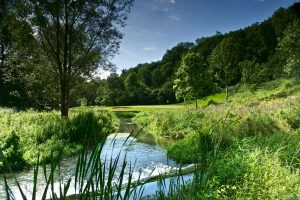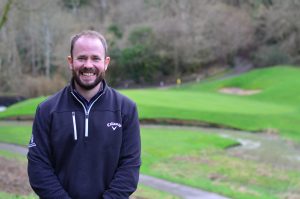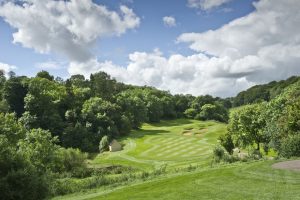Meet the golf course manager: Robert Davies
Related Articles
From The Manor House in Wiltshire, Robert talks about how the use of robotic mowers has helped combat winter worm casts and why greenkeepers deserve more respect for their professionalism than they typically receive.
The Manor House is a 14th century luxury hotel and golf club in Wiltshire. Situated in the quaint Cotswolds village of Castle Combe, with the Bybrook river meandering through its grounds and Italian gardens rising beside the main house, the venue boasts a championship 18-hole golf course.
We speak to Robert Davies, course manager, about maintaining the course.
Can you give a description of your background and how long you’ve now been at the golf club?
In terms of my background in golf, I have been playing since I was 12 when I first picked up a club. The golf bug bit me immediately and I managed to get down to a scratch handicap by the age of 16 and I’ve loved the game ever since.
My time in greenkeeping began back with my first job, having started at The Manor House when I was 18 years old as the young apprentice and now it has come full circle as I’m back as the course manager. If I’m honest, I had no plan or intention to get into greenkeeping as a profession, but I was a member of The Manor House at the time and was looking for my first full-time job. The membership manager at that time mentioned the club was looking for greenkeeping staff and with a bit of luck and good timing, I ended up sitting in front of the then course manager that same afternoon and managed to impress enough to get a job on the greenkeeping staff. I soon realised I loved the job and within that first year I had started my NVQ level two qualification. I stayed at The Manor House for 18 months before moving on to Chipping Sodbury where I worked under a very good head and deputy greenkeeper, John Keenaghan and Tim Needham respectively, and from whom I learnt an awful lot. From there, I moved onto Harbour Town Links in South Carolina for 13 months where I was able to work during two PGA Tour events. While out in the States, I also did a week’s volunteering at Quail Hollow in North Carolina for the week of the PGA Tour event. From here, it was back to the UK and down to Cornwall to work at Trevose, followed by St Enodoc. My partner and I ended up moving back to Gloucestershire, where we both grew up, to take a job at Cotswold Edge, which then led to my current position as course manager at The Manor House.
How has the course evolved in recent years? What projects have you carried out?
The Manor House is a tree-lined parkland course with some holes that have particularly tight tee shots through avenues in the trees. Over time, some of these avenues have become a bit too tight and overcrowded and, in certain places, overgrown with bramble and shrub. We have worked hard to open up the sightlines from these tees with a focus on allowing the outstanding natural features of individual holes to be as visible as possible. This clearance work has also allowed more light and improved airflow through some of our more enclosed teeing grounds.
One major factor that has allowed this work to happen has been the purchase of the Ventrac compact tractor with the tough cut mower deck. This machine has been incredible for us and has allowed us to take on clearance work that would have been done by hand before and therefore would have been far more labour intensive.
Alongside the ongoing clearance work, we have a long-term aim to refine our areas of long rough and do all we can to encourage natural flora and fauna around the course. We currently do a yearly cut and collect using our Amazone but we are looking at increasing this to twice a year.
In addition, we have also identified tees and bunkers as two areas that need improvement. We do get a lot of traffic across the course and some of our teeing areas were designed and built for a lower volume of golf than we have currently. Our long-term plan will be to enlarge the size of the tees but in the shorter term we have increased cultural work across all tees and we have implemented a wetting agent programme to help maintain moisture during the drier months, alongside an enhanced nutrition programme and use of PGRs to improve sward density. Last year was the first time we tried out some more shade-resistant grass species for overseeding and divoting and we saw some very positive results.
We have begun a bunker renovation programme across the course where we will be looking to renovate and reshape, where necessary, all greenside bunkers followed by the fairway bunkers. We initially started this programme of renewal with all work being carried out by contractors, but this winter we have tried a combination approach with a contractor working alongside our greenkeeping team, which will hopefully allow us to complete this work quickly and meaning we can complete the whole programme of renovation sooner
Like a lot of golf clubs, we have had challenges around worm casting with the removal of carbendazim and the associated issues this causes with the smearing of worm casts. We have found this to be a particular problem when combined with the warmer winters we are now having which mean we have to mow fine turf areas longer into the winter which results in further smearing. One exciting development we’ve been looking into is robotic mowing and we have actually just started a six-month long demo on two of our fairways. It’s early days with this demonstration but, with the cutting it’s already done, we’ve noticed that there is little or no smearing of worm casts due to the fact there are no front and rear rollers on the machine. It also benefits from having only four points of contact with the ground which are very thin wheels, this is combined with the fact that it is a very lightweight machine when compared to your standard fairway mower.
What were the biggest challenges you faced in lockdown?
The biggest challenge we had during the lockdowns was the week or two before we reopened for business. We followed the guidance to carry out essential maintenance only, which meant focussing on staying on top of grass growth. This was a challenge and one that we were able to meet, but this level of basic maintenance meant there was a lot of work to catch up on just before we reopened to bring the course back to the standard we would expect. Lockdown was a very strange time as we had no golfers out on the course and although this was very nice in terms of not having any disruption when working, it was also a challenge to stay motivated when cutting grass knowing that nobody was going to use it and enjoy the beautiful surroundings – the motivation of preparing the course for that day’s play was gone.
What growth has the club seen by way of members and play since then, and what challenges has this brought?
We have seen fabulous growth in our membership which has led to a major change in our business mix. Membership is well and truly rooted at the heart of what we do and this allows us to yield better when it comes to visitor golf. The Manor House is very well set up to deliver memorable corporate days and green fee payers will be very well looked after with pyramids of range balls on arrival and a course that is set up to a very high standard.
Crane fly larvae has been a major issue on UK golf courses lately, has this impacted you and how have you dealt with it?
In general, we haven’t been too bad across the site, although we did have evidence of some damage on our eighth and 13th greens. We treated these selected areas with an application of Acelepryn and this season will see us continuing to closely monitor numbers of grubs per metre squared to see if we need any further applications of Acelepryn.
What advice would you give to youngsters starting out and wanting to pursue a career in the profession?
Hard work, hard work and more hard work! It may be cliché, but I think a good work ethic and an ability to graft are important throughout your working career, especially when starting out and in your early years in the profession when you are trying to learn your craft. Your skills will come with time in the industry and you will be aided if you ask the right questions and pay attention to what more skilled members of the team are doing.
I think the current challenges of pesticide removal and a changing climate are presenting major issues for all greenkeepers and it’s very important to keep an open mind to new methods and ideas. It feels as though we’re going through a period of strong innovation in the industry as people look for different ways around certain problems, even if some of these ideas go against conventional wisdom.
What changes do you think need to be made to benefit the industry sector and profession of the greenkeeper?
I’ve found that it has varied at every club I’ve worked at but, at some clubs, I do feel that greenkeepers quite often don’t get the respect they deserve from certain areas of the membership. We are hardworking, honest people, doing our absolute best for the course and club in what can, at times, be very difficult circumstances. We’re passionate about what we do and I think some people would be surprised at the level of dedication and professionalism within the industry. I feel with the current issues around pesticide revocation and a changing, more extreme climate, we deserve more respect than ever. Although I know this has been discussed many times before, I do feel like we as an industry need more legislative support around the revocation of chemicals. There seems to be a large disparity between what chemicals are allowed for agriculture and amenity turf and I hope that this is something that we can continue to see discussed going forwards.






























